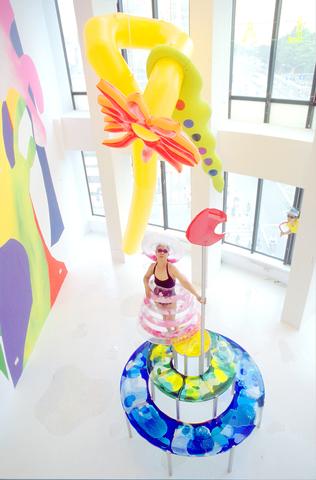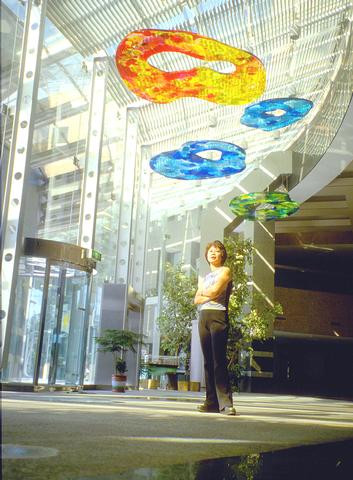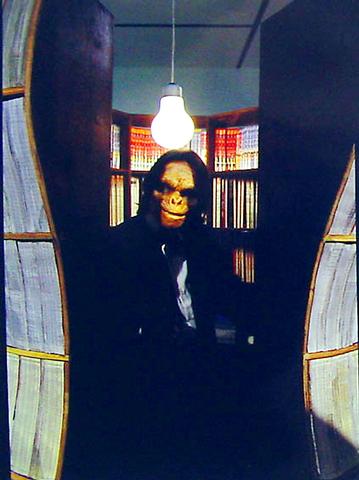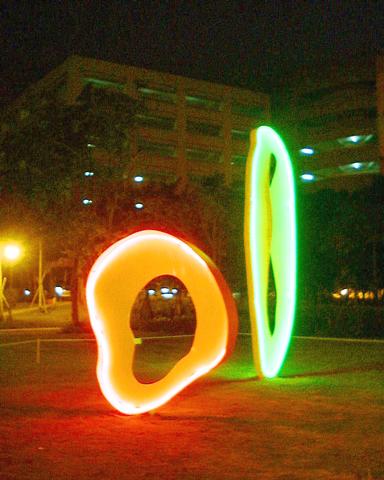IN 1997, Taiwan's community was eagerly awaiting the opening of the country's first international artists village, hoping it would position the island alongside other countries that use such facilities as platforms to promote international arts exchange and settings for artists in which to work.
Sponsored by the Council for Cultural Affairs (CCA, 文化建設委員會), the village, which was to be located in scenic Nantou County, looked ready to break ground until it was unceremoniously dumped by the incoming DPP government last year in favor of a decentralized policy to convert idle land and buildings into art spaces.
Under the new policy, responsibility for establishing artists villages was shifted to local governments and the private sector. The planning office for the Taiwan International Artists Village (藝術村籌備處), which oversaw the Nantou project now functions as a resource center to support smaller local projects.

PHOTO COURTESY OF JUNE LAI
One off-shoot of the scrapping of the arts village is a program of international arts exchanges called the Artists-in-Residencies Sponsorship Program (視覺藝術人才出國駐村創作交流計劃), which is designed to gain a better understanding of the operations and functions of arts villages and to give local artists greater international exposure.
After three years as head of the planning office for the scrapped Nantou project, CCA's director Yang Shiuan-Chyn (楊宣勤) is nevertheless enthusiastic about this pioneering program.
"We are sending artists into the world first, to experience various well-established arts villages and give us feedback," Yang said.

PHOTO COURTESY OF JUNE LAI
The artists-in-residencies program, with an annual budget of NT$3 million kicked off last year with 10 artists heading to five art villages in the US and one in the UK. The program is intended to supplement a Ministry of Education program, begun in 1991, which sponsors three artists each year at the Cite Internationale des Arts in Paris.
The new program has proved very popular, with more than 70 people applying for the 10 available spots last year.
Not just a holiday

PHOTO COURTESY OF CHEN LONG-BIN
For Chen Long-bin (陳龍斌), who selected the 18th Street Arts Complex in Santa Monica, California, it was like "arriving in paradise." Chen was the oldest artist among the first batch to be sent abroad and already had international experience and some commercial success in Taiwan.
Chen is best known for his sculptures in which he takes books, magazines or even phone directories, stacks them, and sculpts them into a human face. His work seeks to explore the relationship between books, the mind and culture. Returning from his trip, his work has taken on more monumental proportions and a more relaxed and humorous tone.
Works by the 10 participating artists from last year are currently on exhibit at the Taipei Fine Arts Museum. Chen's work on display is a book sculpture expanded into a multimedia and performance project titled Reading Room -- Dr Gorilla Show. In the piece, Chen can be seen on a video recording dressed as a gorilla, in a mockery of intellectual hypocrisy.

PHOTO COURTESY OF JUNE LAI
"The international art village experience helped me to expand the scope of my art," Chen said, adding that Dr Gorilla was inspired by the film studios and the make-up shops he visited in California.
Lee Yi-chuan (李宜全), a local artist still in graduate school, also found inspiration from his experience last year at the Art Omi International Arts Center, located at a farm outside New York. He found it rewarding being in an international environment where he could interact with artists from around the world.
"It was the first time I really felt different and realized what makes me unique as someone from a different culture not much known to the world," said Lee, who began to look to his Taiwanese cultural roots for material to make art.
But Lee also felt that his own lack of experience limited the benefits he received from the program, saying that he does not yet have a large enough portfolio to present critics and galleries in New York. "I felt I passed up some good opportunities," he said. Others among the young artists concurred with this assessment.
For artists seeking greater exposure, the villages are excellent locations, as most would arrange for art critics, museum professionals and gallery owners to visit and meet with the resident artists.
Questionable selection
One aim of the program was to discover how artists react to their overseas experience and the activities that they found useful. From the mixed response after the program's first year, the cultural affairs council's resource center felt that its selection of artists had been slightly off target.
The panel tended to favor young artists, whom they believed would benefit most from a first overseas experience. Nine out of the 10 chosen artists, most about 30 years old, were still studying for their master's degree when they applied for the program. Chen Long-bin (陳龍斌) was almost excluded from the program on account of his age.
Chen, who regards himself as an established, mid-career artist, said he found inspiration and garnered opportunities during his three-month stay in California. But most significantly, both for himself and for the program, he was the only one of the 10 artists who was invited to exhibit at a gallery and at an upcoming art fair in San Francisco. He also sold a number of sculptures. This success led the CCA to invite him to join the selection panel for this year. The list of successful candidates this year already shows a significant shift in favor of older, more established artists.
Chen feels that artists in mid-career will benefit more from the program because they, more than student artists, need to keep in touch with the latest developments in the art world and be afforded opportunities.
Among those selected for this year, were June Lai (賴純純), 48, an installation artist known for her public artwork made of tinted plexiglas and Li Ming-shen (李銘盛), 49, the first Taiwanese artist to participate in the Venice Biennial in 1991.
By changing the age and qualifications of the selected group, Yang's office is aiming for better results. Lai, for one, is expecting a fruitful trip.
"There's different kinds of life experience for an artist at different stages in their careers. And this is the time I feel ready to go out and present myself with a handsome portfolio from the past 20 years to the major people in New York." The program is a precious channel for Lai. "If I went to New York by myself, I wouldn't get to meet these people," says Lai.
Knowledge for the future
The experiences of the artists studying at art villages abroad are documented by the resource center. The CCA Artists-in-Residencies Sponsorship Program is a large part of the center's services, a reference point for the setup of art villages around the country in the future.
Secretary of the association Shih Long-sheng (石隆盛) pointed out that Taiwan does not have much experience in running arts villages and the returning artists are a rich resource for reference.
Currently various agencies in Taiwan are gearing up its process to establish art villages around the country. Taipei's premier alternative space, the Hwa-shang Art District (
Managed by the private foundation Association of Environmental Reform for Arts and Culture in Taiwan (中華民國藝術文化環境改造協會), the alternative space makes use of a disused winery complex. The association hopes to secure further funding to expand the space to include artists' studios, the first step to making it a full-fledged artists village.

In the March 9 edition of the Taipei Times a piece by Ninon Godefroy ran with the headine “The quiet, gentle rhythm of Taiwan.” It started with the line “Taiwan is a small, humble place. There is no Eiffel Tower, no pyramids — no singular attraction that draws the world’s attention.” I laughed out loud at that. This was out of no disrespect for the author or the piece, which made some interesting analogies and good points about how both Din Tai Fung’s and Taiwan Semiconductor Manufacturing Co’s (TSMC, 台積電) meticulous attention to detail and quality are not quite up to

April 21 to April 27 Hsieh Er’s (謝娥) political fortunes were rising fast after she got out of jail and joined the Chinese Nationalist Party (KMT) in December 1945. Not only did she hold key positions in various committees, she was elected the only woman on the Taipei City Council and headed to Nanjing in 1946 as the sole Taiwanese female representative to the National Constituent Assembly. With the support of first lady Soong May-ling (宋美齡), she started the Taipei Women’s Association and Taiwan Provincial Women’s Association, where she

Chinese Nationalist Party (KMT) Chairman Eric Chu (朱立倫) hatched a bold plan to charge forward and seize the initiative when he held a protest in front of the Taipei City Prosecutors’ Office. Though risky, because illegal, its success would help tackle at least six problems facing both himself and the KMT. What he did not see coming was Taipei Mayor Chiang Wan-an (將萬安) tripping him up out of the gate. In spite of Chu being the most consequential and successful KMT chairman since the early 2010s — arguably saving the party from financial ruin and restoring its electoral viability —

It is one of the more remarkable facts of Taiwan history that it was never occupied or claimed by any of the numerous kingdoms of southern China — Han or otherwise — that lay just across the water from it. None of their brilliant ministers ever discovered that Taiwan was a “core interest” of the state whose annexation was “inevitable.” As Paul Kua notes in an excellent monograph laying out how the Portuguese gave Taiwan the name “Formosa,” the first Europeans to express an interest in occupying Taiwan were the Spanish. Tonio Andrade in his seminal work, How Taiwan Became Chinese,